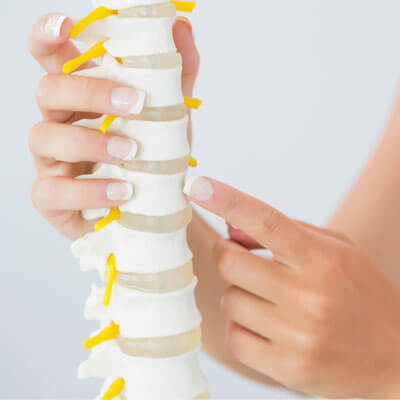What is Lumbar Spinal Stenosis?
 Stenosis means that there is abnormal narrowing of certain passages. In the spine, we have multiple passages which typically house the nerves that provide our bodies with sensation, ability to contract our muscles, and more.
Stenosis means that there is abnormal narrowing of certain passages. In the spine, we have multiple passages which typically house the nerves that provide our bodies with sensation, ability to contract our muscles, and more.
Stenosis within the spine can occur in a variety of locations:
- Central stenosis refers to narrowing of the central spinal canal. This large opening is where we have the spinal cord traveling from the brain to the bottom-most part of the spine
- Lateral stenosis occurs within the smaller canals that shelter the nerves as they exit the spinal cord. Once the nerves leave the spinal cord, they are called nerve roots.
- Central canal stenosis would affect the spinal cord and potentially, both sides of the body.
- Stenosis results in narrowing of these tunnels, which may eventually result in nerve compression, pain, weakness, loss of sensation, and more.
A Little More On the Nerves
The spine is divided into sections: cervical, thoracic, lumbar, sacrum, and coccyx. Each section is then numbered to help identify the exact nerve we are trying to describe. There are 5 cervical, 12 thoracic, 5 lumbar, and 5-4 sacral and coccygeal levels. Each level corresponds to a nerve root as it exits and separates from the spinal cord, passing through one of the smaller canals described above.
This beautiful organization of the spine allows clinicians to diagnose problems based on where the symptoms are being felt. If you’ve ever worked with me, you may remember that I ask which specific location you feel the symptoms; is it on the front or back of the leg? Is it on the inside or outside of the ankle?
The location and type of symptoms that someone with stenosis feels, depends on which nerve is affected and where the stenosis occurs.
What Are the Symptoms?
With central lumbar stenosis, it is possible to feel symptoms along both sides of the lower limb, whereas with lateral lumbar stenosis you only feel symptoms on the side that is affected. One of the tricky things about this condition is that it does not affect everyone the same! The following are some of the most common types of symptoms:
- Pain in the back, hips, buttocks
- Numbness, burning, or tingling sensation in the legs
- Weakness and quickly to fatigue muscles of the legs
- Loss of balance and difficulty walking
- Cramping sensation
- Pain that is often worsened by bending backwards and relieved by slouching*
Patients with stenosis often develop a slouched posture and often get relief when leaning forward. This is called a positive “shopping cart sign.” In some severe cases of stenosis, there may be sexual dysfunction, loss of bladder control and other more serious symptoms. If any of these are present, seek immediate medical attention.
Treatment Options
There are very few scientifically proven treatments for lumbar spinal stenosis, but fortunately, the few options often have great results. We do have to keep in mind that stenosis often occurs from spinal arthritis. There is no complete cure for this condition but there are great ways to manage.
Whenever we make recommendations for the treatment of any condition, it is very important to weigh the risk-to-benefit ratio. These are three of the more common ways to manage this condition:
The Lumbar Spinal Stenosis Bootcamp
This 6-week program combines evidence-based manual therapy with a specific exercise regime that focuses on a variety of objectives:
- Spinal decompression therapy
- Flexion-based mobilisations
- Strengthening of the core, pelvic muscles, and spine supporting muscles
There are very few facilities that are certified to offer this program, and Ottawa Health: Performance and Rehabilitation is one of them! This program has been researched and documented to improve the symptoms of lumbar stenosis and regain some of the lost abilities.
Medications and Proper Nutrition
Medications such as non-steroidal anti-inflammatories are some of the most commonly used medications for relieving some of the pain. It is important to understand that medications may relieve pain, but it is impossible to resolve the underlying problem with medications only. You may be able to manage it for some time, but be wary of false expectations.
Surgery
This may include removing bone spurs or larger pieces of bone, such as a laminectomy. While this approach should be reserved for the more severe cases of lumbar spinal stenosis, it is often recommended once the above two recommendations have been attempted.
Managing Lumbar Spinal Stenosis
The key to all success is prevention and preparation for obstacles. Unfortunately for conditions like these, the underlying problem began long before your symptoms became obvious.
Managing lumbar spinal stenosis should include specific exercises to prevent further deterioration. The selection of exercises should be done alongside a professional who understands the condition. It is very easy to exacerbate the symptoms with poor exercise choices.
Nutrition is important to prevent excessive weight gain and malnutrition. Exercises should target some muscle growth which requires proper nutrition. A healthy diet should provide you with enough energy to perform the exercises and also the proper elements to build muscle or prevent further loss.
Key Points
- Lumbar spinal stenosis develops over decades, it does not have a cure but there are ways to manage and prevent rapid deterioration
- There is no cure, but there are ways to manage the symptoms
- Doing nothing is the worst thing you can do! Physical activity helps nourish muscles and joints. A proper exercise routine is the best thing you can do. Seek a professional who understands and has studied lumbar spinal stenosis

 2022, 2023, 2024
2022, 2023, 2024